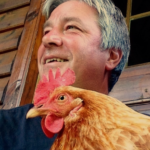
Anyone interested in poultry care should understand chickens’ internal workings. One interesting aspect of avian biology is the cloaca, an essential part of a chicken’s anatomy.
The cloaca, the vent in bird species, has many roles. It serves as the exit point for digestive waste, including “urine,” the entry route for reproductive cells, an antibody manufacturing facility to keep chickens healthy, and sometimes, under certain conditions, an organ for respiration in some bird species.
Now that you understand what the cloaca is and why it’s important, it’s time to explore its intricate structure. This knowledge is academically fascinating and crucial for identifying and treating common health issues in these birds.
Anatomical Structure of the Chicken Cloaca
A chicken’s cloaca consists of three distinct sections or chambers: the fecal chamber (Coprodeum), the urogenital chamber (Urodeum), and the cloacal chamber (Proctodeum). Each serves a unique function. The fecal chamber receives waste from the digestive system, the urogenital chamber is for urinary waste and reproductive functions, and the cloacal chamber is the final holding area before waste is expelled.

These components make the cloaca an organ of complex functionality, serving excretory and reproductive roles simultaneously. During mating, the cloaca expands to allow sperm transfer, illustrating its critical role in chicken reproduction.
Examining this further, the cloaca’s anatomy highlights stark differences from the separate channels found in mammalian systems, showcasing nature’s diverse approaches to biological processes. Through this lens, the cloaca isn’t just a curiosity – it’s a remarkable adaptation ensuring efficiency in avian species.
Transitioning into the health aspect, the cloaca’s multipurpose design means issues can affect more than excretion; they may also impact a chicken’s ability to reproduce or lay eggs. This underscores the need for a broad understanding of cloacal disorders, ranging from simple irritations to complex infections.
Common Health Concerns and Cloacal Disorders in Chickens
Like other pets or farm animals, chickens can encounter various health issues. Their cloaca, a vital part of their anatomy, is no exception.
I want you to understand the typical cloacal concerns, how they can affect your chicken’s health, and what symptoms might alert you to these problems.
One of the most common issues is cloacitis, or vent gleet. This inflammation of the cloaca can arise from bacterial infections, parasites, or even long-term use of antibiotics that disrupt the normal cloacal flora. Look for swelling, redness, or discharge around the vent area.
Vent prolapse is another condition that I see all too often. This potentially serious issue occurs when part of the cloaca is expelled outside of the body, usually after excessive straining during egg-laying or due to severe diarrhea. Immediate attention is fundamental, as untreated prolapses can be fatal.
Preventative care plays a crucial role in keeping cloacal problems at bay. This includes regular cleaning of the living area to prevent infections, proper nutrition to avoid excessive straining during egg-laying, and stress reduction, as stress can exacerbate health issues.
Also, be vigilant for early signs of cloacal disorders and maintain a relationship with a veterinarian who can offer treatment advice or intervention when necessary.
Various treatments may be recommended to address these health concerns, ranging from dietary adjustments and supplements to improve overall health to antiparasitic drugs, antibiotics, or, in severe cases, surgery. Remember, early diagnosis and treatment are best for positive outcomes.
Human interaction, through the management of diet and environment, plays a critical role in preventing and managing cloacal health.
Creating living conditions that promote the well-being of our chickens is a responsibility to be taken seriously. In the wild, chickens would never have to walk around in filth.
Human Interaction and Impact on Cloacal Health
I cannot stress enough how the health of a chicken’s cloaca is influenced by its care and the conditions in which it lives.
Diet and environment play crucial roles in maintaining a healthy cloaca.
Ensuring chickens have access to a balanced fiber-rich diet can promote healthy digestion and prevent issues like vent gleet or impaction.
Moreover, clean living conditions are essential. Chicken keepers should regularly clean coops to minimize the risk of infection and parasites affecting the cloaca.
Simple measures like providing adequate space, clean water, and monitoring for signs of distress can substantially impact the well-being of these birds.
The ethical considerations in poultry farming are also important. Overcrowded conditions, poor hygiene, and stressful environments can lead to health problems, including those affecting the cloaca.
UPHOLDING HIGH STANDARDS of animal welfare is not only ethically responsible but also integral to preventing diseases and ensuring the production of safe, quality poultry products.
Many may overlook this part of chicken anatomy, but its health is a reliable indicator of overall well-being.
By understanding the complexities of the cloaca and how it’s affected by human interaction, we create a stronger foundation for hobbyists and poultry care professionals.
Thanks for stopping by.
Dave

Chickenmethod.com

